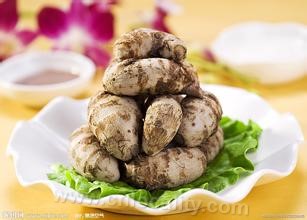welcomeSpecialty Foods Products!

Taro (yù nǁ i) is called "taro" for short, commonly known as "taro". Monocotyledon, Araceae. Perennial herbs. The leaves are oval and the petiole is long and fat. The flowers are yellow and green. There are fleshy bulbs under the ground, which are rich in starch and can be eaten. There are many cultivated plants in southern China. The nutritional value of taro is very high, and the starch content in tuber reaches 70%. Taro can be used as both food and vegetables. It is a tonic suitable for all ages, and it is a treasure for vegetarianism in autumn. Taro is also rich in protein, calcium, phosphorus, iron, potassium, magnesium, sodium, carotene, nicotinic acid, vitamin B1, vitamin B2, saponin and other ingredients. According to Chinese medicine, taro is sweet, pungent and flat, and when it enters the intestine and stomach, it has the effects of benefiting the stomach, widening the intestine, relaxing bowels, resolving hard mass, tonifying the middle warmer, benefiting the liver and kidney, and replenishing essence and marrow. It has a certain effect on adjuvant treatment of dry stool, goiter, scrofula, mastitis, insect biting bee sting, intestinal insect addiction, acute arthritis and other diseases. However, it should be noted that it should not be rubbed or applied to healthy skin, otherwise it will cause dermatitis. Once it happens, you can gently scrub with ginger juice. There are many ways to eat taro, such as boiling, steaming, stewing, roasting, roasting, frying and stewing. The most common way is to cook or steam taro and dip it in sugar. Roast taro or cut taro into diced pieces and mix with corn to cook porridge. It should be noted that taro contains more starch, so you can't eat more at a time. Eating more has the disadvantage of stagnation of qi, and raw food is slightly toxic. In the southeast coastal area, there is the custom of eating taro in the Mid-Autumn Festival. According to legend, during the Ming Dynasty, the Japanese invaded the southeast coast of China, and the people suffered greatly. Qi Jiguang was ordered to resist Japan and won a great victory. On the Mid-Autumn Festival, Qi Jiajun celebrated the Mid-Autumn Festival in the camp. In the middle of the night, the enemy attacked, besieged the Qi army on the mountain and cut off its food and grass. A few days later, the soldiers had to dig up a lot of wild taro, which was delicious after cooking, but I don't know its name. Qi Jiguang said: "In order to commemorate the soldiers who died, let's call it' death'." One night, after a hearty meal, Qi Jiajun bravely broke through and wiped out the enemy in his sleep. Since then, people in the southeast coastal areas will eat candied taro during the Mid-Autumn Festival to remember the national crisis and Qi Jiguang's achievements in resisting Japan. After a long time, "being killed" gradually became "taro". "Sweet-scented osmanthus sugar taro" made from it has a unique flavor, which makes people salivate, and it is an essential name for the Mid-Autumn Festival in August in Jiangnan. Taicang has planted more than 8,000 mu of taro all the year round, with an annual output of more than 20,000 tons.
Reprinted with attribution:
https://cnlocality.com/(Chinese Specialty Products)
other
consult:(+86)13225231905